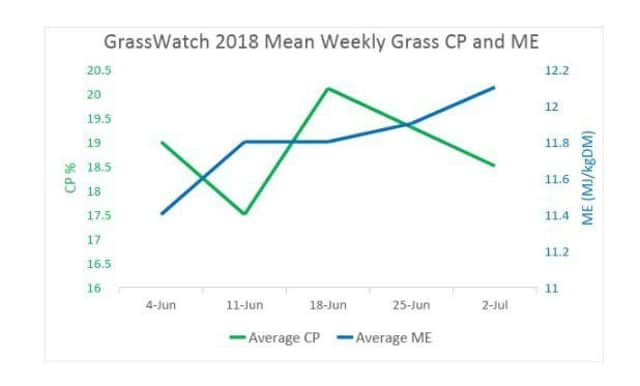GrassWatch project monitors grazing covers


The project measures pre-grazing grass covers and quality on 12 monitor farms across Northern Ireland, along with partner feed mills. GrassWatch assists these monitor farms with managing their grazing rotations more accurately by observing trends in grass covers and quality.
It uses this data to predict the milk yield that the grass will sustain at various levels of dry matter intake and assesses how milk quality is affected through producing a butterfat alert based on rumen acid load and fibre index. The partner mills can then use this information to help farms in their area.
Advertisement
Hide AdAdvertisement
Hide AdSince the beginning of June this year, GrassWatch found that the average grass metabolisable energy (ME) increased from 11.4 to 12.1MJ/kgDM. This could be due to the lower undigestible fibre content, meaning a greater proportion of more grass dry matter is available to the cow for digestion. At 15kgDM intake, the energy obtained from grass increased from 171 to 182MJ/day, resulting in predicted milk yield from grass also increasing, from 18.1 to 20.1 litres. GrassWatch was also carried out during 2016. During June 2016, grass ME also increased but was generally lower. Therefore, if cows eat the same amount of grass this year, it should be able to support a higher milk yield. However, grass is in short supply in many places at present.
This year, average crude protein (CP) figures are consistently lower than during 2016 and have seen greater fluctuations, within the range 17.5 to 20.1%. Variations in grass CP across farms tend to be due to grass growth stage and time of year, but also management factors such as fertiliser regime. Recent challenging conditions with low rainfall and soil moisture, could be preventing fertiliser nutrients being dissolved and washed into the soil. This may be reducing the uptake and conversion of nitrogen to true protein in the grass plants. It is important to analyse the weather forecast prior to sowing fertiliser, especially on very dry paddocks with little cover.
The fermentable energy and protein balance (NFEPB) has consistently exceeded the ideal threshold. This means the grass is providing more protein than the cow’s rumen can efficiently use, therefore protein loss occurs, with potential negative effects on fertility.
The weekly butterfat alert is made up of many feed measurements to alert farmers of the risk of butterfat depression. This has been evident on the GrassWatch monitor farms as their bulk tank butterfat has been decreasing slightly.
Advertisement
Hide AdAdvertisement
Hide AdThere has been a large range in pre-grazing covers across the monitor farms, with last week’s covers ranging from 2,350 to 4,300kgDM/ha, however there has also been a clear downward trend on the farms since the beginning of the project. This is reflected by the decreasing grass growth rate from 91.3 to 33.4 kgDM/ha/day, (AgriSearch GrassCheck, 2018). The desirable pre-grazing cover is 3,200kgDM/ha as it allows optimum grass utilisation while encouraging best quality regrowth. GrassWatch farmers have been maintaining the same grazing area and average rotation of 22 days, but to compensate for poor growth, most are buffer feeding big bale silage and some have even opened this year’s first and second cut silos.
Next month’s update hopes to discuss whether or not the recent rain will have improved the current grazing situation. Follow us on Twitter @TrouwNutr_IRE for weekly GrassWatch reports.